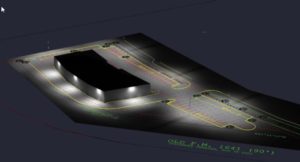If the goal of a lighting design project is to produce even coverage over a large area, then the only proper approach is with photometric diagramming. Photometric analysis allows an installer to put together a precise arrangement of fixtures, and predict how those fixtures will interact to produce a cohesive, comfortable level of illumination. This approach can work for a variety of venues, including sports arenas, parking lots, commercial and industrial properties, equestrian areas, amusement parks and anywhere else where significant exterior illumination is needed.
The Elements of Lighting Design
 Regardless of the project’s scope or location, there are a number of considerations that must be made for every setup. These elements are built into a full photometric analysis and allow property owners to see how their fixtures will look once they are installed. Some of these factors include:
Regardless of the project’s scope or location, there are a number of considerations that must be made for every setup. These elements are built into a full photometric analysis and allow property owners to see how their fixtures will look once they are installed. Some of these factors include:
Fixture Arrangement – Perhaps the most important consideration is where the fixtures will go. If they are too far apart, the area will appear too dark from ground level. If the fixtures are too close, they will appear intense and uncomfortable. Photometric diagramming allows fixture installers to determine the optimal distance between fixtures, using a metric known as luminous flux. Luminous flux can be measured in lumens or in foot candles, and describes the perceived intensity of illumination in a given area, usually measured in one-foot increments. During photometric diagramming, installers can see how foot candles rise or fall with a different arrangement of the fixtures. There is a particular value that is considered optimal for every setting, and this value will be the target when arranging the fixtures in photometric analysis software.
Color Temperature – For exterior applications, it makes sense that a property owner would want bright illumination. This not only makes it easier to see, it also blankets the area in a bit more security, as there is less likely to be dark spots. Color temperature plays a role in this, as warmer color temperatures (orange and yellow) tend to appear darker than white and slightly cool fixtures. As such, fixture experts prefer technologies that can produce neutral and slightly cool color tones, such as LED and metal halides. Older technologies, like pressurized sodium fixtures, are cheaper, but less reliable and not as bright.
Pole Construction – Taller poles produce softer illumination at ground level. Shorter poles are more intense in a smaller area. The wind rating of the pole is also taken into account, as well as the weight of the fixture attached to the pole. All of these together will determine how the fixture installer sets up the pole and what kind of pole to use.
These are highly technical elements that cannot be done by feel, but must be accomplished with the use of specialized technology and specialized expertise. For this reason, it is always best to bring in an experienced lighting design team to provide oversight and guidance. The result will be a set of fixtures that are more cohesive, more effective and more efficient.




